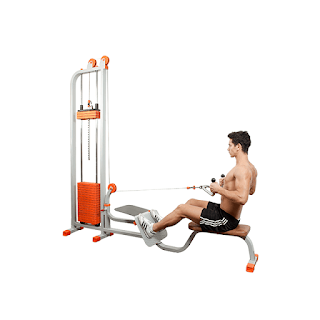Conquer the King: Master Deadlifts for Unmatched Back Strength (Build Power & Muscle!)
 |
| Deadlifts 5 sets and 3/3/3/2/1 reps |
 |
| Deadlifts 5 sets and 3/3/3/2/1 reps |
 |
| Deadlifts 5 sets and 3/3/3/2/1 reps |
 |
| Deadlifts 5 sets and 3/3/3/2/1 reps |
 |
| Deadlifts 5 sets and 3/3/3/2/1 reps |
 |
| Deadlifts 5 sets and 3/3/3/2/1 reps |
Hey back builders! Want to develop a powerful, impressive back that screams strength? Chin-Ups are a challenging calisthenics exercise that targets your latissimus dorsi muscles. This guide will turn you into a chin-up master with the perfect rep scheme, proper form breakdowns to avoid injury, and even a handy video for visual learners.
Building a Back of Steel:
Chin-Ups are a bodyweight exercise that allows you to build impressive strength and muscle mass in your back. Strong lats not only improve your posture and physique but also enhance pulling power for various exercises and overall athletic performance.
Reps, Sets, and Back Domination:
A popular rep scheme for chin-ups is 4 sets of 12/10/8/6 reps. This means you'll perform 4 sets, gradually decreasing the reps (12, 10, 8, 6) while adding weight (weight belt) or progressing to harder variations as you get stronger to progressively challenge your lats and grip strength. You can also start with assisted chin-up machines or negatives (controlled descent from the top) if needed.
Mastering the Chin-Up (Control & Focus):
Here's how to conquer the Chin-Up with perfect form (check the video for a visual breakdown!):
Bonus Tip: Maintain good posture throughout the movement. Avoid arching your back or kicking your legs for momentum. Focus on using your back muscles to pull yourself up.
With focused training and this guide, you'll be well on your way to conquering those chin-ups and building the back of steel you've been dreaming of. Now go out there and dominate the bar!
 |
| Chin-Ups 4 sets and 12/10/8/6 reps |
 |
| Chin-Ups 4 sets and 12/10/8/6 reps |
 |
| Chin-Ups 4 sets and 12/10/8/6 reps |
Hey back warriors! Want to build a broader, stronger back that will turn heads? Lat Pulldowns are a fundamental exercise to target your latissimus dorsi muscles. This guide will turn you into a Lat Pulldown pro with the perfect rep scheme, proper form breakdowns to avoid injury, and even a handy video for visual learners.
Building a Herculean Back:
Lat Pulldowns are a versatile exercise that allows you to focus on sculpting and strengthening your latissimus dorsi muscles. Strong lats not only improve your posture and visual physique but also enhance pulling power for various exercises and overall athletic performance.
Reps, Sets, and Lat Domination:
A popular rep scheme for lat pulldowns is 4 sets of 12/10/8/6 reps. This means you'll perform 4 sets, gradually decreasing the reps (12, 10, 8, 6) while increasing the weight to progressively challenge your lats. Choose a weight that allows good form on the first set, pushing yourself to near failure on the last few reps of each subsequent set.
Mastering the Lat Pulldown (Control & Focus):
Here's how to conquer the Lat Pulldown with perfect form (check the video for a visual breakdown!):
Bonus Tip: Focus on using your lats to pull the weight down, not your biceps. Maintain good posture throughout the exercise and avoid arching your back excessively.
With focused training and this guide, you'll be well on your way to that impressive, Herculean back you've been dreaming of. Now go out there and crush those Lat Pulldowns!
 |
| Lat Pull-Downs 4 sets and 12/10/8/6 reps |
 |
| Lat Pull-Downs 4 sets and 12/10/8/6 reps |
 |
| Lat Pull-Downs 4 sets and 12/10/8/6 reps |
Hey gym rats, let's talk back day! Seated Cable Rows are a killer exercise to sculpt a wider, stronger back. This guide will turn you into a seated cable row master, with the perfect rep scheme, proper form tips, and even a handy video for visual learners.
Building a Back Like a Superhero:
Seated Cable Rows are your secret weapon for building a ripped back. They target your latissimus dorsi (lats), those impressive V-shaped muscles under your shoulder blades. Strong lats not only look good, but they also improve posture, pulling power, and overall upper body strength.
Reps, Sets, and Crushing Your Workout:
A popular rep scheme for seated cable rows is 4 sets of 12/10/8/6 reps. This means you'll perform 4 sets, gradually decreasing the reps (12, 10, 8, 6) while increasing the weight to challenge your muscles progressively. Choose a weight that allows good form on the first set, pushing yourself to near failure on the last few reps of each subsequent set.
Mastering the Seated Cable Row:
Here's how to conquer the Seated Cable Row with perfect form (check the video for a visual breakdown!):
Bonus Tip: Focus on squeezing your lats throughout the movement to maximize muscle activation. Don't just move the weight; feel it working your back!
With this guide and some dedication, you'll be rocking a superhero-worthy back in no time. Now go out there and crush those seated cable rows!
 |
| Seated Rows 4 sets and 12/10/8/6 reps |
 |
| Seated Rows 4 sets and 12/10/8/6 reps |
 |
| Seated Rows 4 sets and 12/10/8/6 reps |
 |
| Seated Rows 4 sets and 12/10/8/6 reps |
 |
| Seated Rows 4 sets and 12/10/8/6 reps |
This is a notification message.